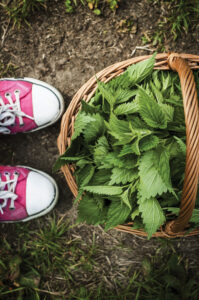
Collecting our own wild foods can be empowering and enriching to both our lives and our diets. Learn the benefits of foraging, how to do it responsibly, and about a few great edibles you can seek out to get you started.
Often, we forget that just a short foray outside our doors can reveal nature’s own food system: edibles springing forth through no human effort at all—just the power of sunlight and whatever water falls as rain or snow. What a beautiful opportunity to regain some real sovereignty over how we feed ourselves!
Done right, foraging for wild foods can be one truly sustainable way to contribute to our diet, immerse ourselves in the nature around us, and obtain maximum nutrition while we’re at it.
Why wild?
Engage with place
Slowing down to scan for edibles allows us to pick up on details of a place: the abundance of plants; the sounds of insects, birds, and breeze; the smells of the season. This is how we begin to know a place, to participate in and belong to it.
Optimal nutrition
The same phytonutrients that give wild plants their fitness to survive are the ones that help us ward off illnesses such as cancer and heart disease. Jo Robinson, author of Eating on the Wild Side (Little, Brown and Company, 2014) says, “… studies I’ve seen show that wild foods have at least twice as many phytonutrients as their domesticated counterparts and as much as 50 times more in some cases. It’s quite impressive.”
Sustainable alternative
Wild foods come from within functioning ecosystems with no need for additional irrigation, fertilizers, pesticides, or lengthy transportation. If we forage conscientiously, we can draw sustenance while still allowing these systems to thrive. Some edibles, however, proliferate where there has been a disturbance, in which case foraging makes the most of that disruption.
Tip
Foraging is prohibited in national and provincial parks as well as some municipal parks, so turn to public lands not under protection or seek permission from landowners, urban or rural. Be sure the area you choose is clean and chemical free.
Doing it right
If we’re going to do this, let’s do it right. In our zest for wild foods, it would be easy for us to repeat our pattern of depleting ecosystems to fulfill our appetites. If we enter a natural space to partake of the food it offers, let’s do it in such a way that it continues to thrive not only for next season’s harvest, but for generations.
Julie Walker, an Alberta naturalist and outdoor educator who’s been working with edible plants for more than 10 years, offers the following advice.
Know your ecosystem
What does a healthy population of the species you’re collecting look like? Is it abundant enough to support some harvesting long term? This is where an outing or two with a local naturalist or experienced wildcrafter is invaluable.
Choose strategically
We can actually shift ecosystem balance in favour of native species by targeting introduced species for our harvest and deliberately dispersing native plant seed heads along the way.
Harvest no more than 5 percent of any one species in the area
This allows the plants to regenerate, animals to get their winter rations, and other foragers to potentially take 5 percent.
Rewild your garden
Take the pressure off natural spaces by planting species you wish to forage right outside your door.
Consult an expert
Positively identifying a species is crucial, but we also need to understand when to harvest it, what parts and amounts can be safely ingested, and how to properly prepare it for consumption. Local experts are the keepers of this cultural knowledge; consult them in person or via field guide to be sure you enjoy your adventures without ill effect!
Forage these
Get your foraging off to a good start with these abundant wild foods.
Fireweed
Named for its tendency to grow where fires have occurred, fireweed’s early spring stems have historically been boiled or steamed by Indigenous people. Look for new springtime shoots in sites of disturbance, including along streams, lakes, and bogs.
Try them:
New shoots can be eaten raw in salads or cooked like asparagus (in a stir-fry or frittata); more mature stems need peeling. Flower bud clusters can be cooked, while open flowers add beauty to a meal.
Conifer tips
With a resinous and lemony flavour, these bring just the vitamin C-rich awakening we need after a long winter. Pluck the tender, pale green growing tips of spruce, fir, pine, or larch in the spring just as their papery husk is falling off, leaving plenty on the tree so it can grow in all directions.
Note: Avoid yew trees as the needles (and the berries and bark) are toxic to consume.
Try them:
Delicious on salmon, pickled, in shortbread, or as a pesto or tea.

Rosehips
Cheery dots of red in the fall and winter landscape, rosehips pack a hefty punch of vitamin C and are best harvested after at least one frost. Because the seeds shouldn’t be eaten, processing can be slightly labour intensive, but once obtained, a silky rosehip paste is a distinct and versatile treat.
Try them:
Somewhere between a berry and a squash in flavour, the flesh can be made into jam or syrup, or added to a soup, chutney, or smoothie. Alternatively, simply dry, crush, and steep the hips for a nutritive winter tea.
Stinging nettle
Another springtime treat, look for these nutrient-packed, allergy-fighting greens where there has been some previous disturbance. (Look for harvesting suggestions in our Spring Nettles Vichyssoise recipe.)
Try them:
Use in the same way you would any cooked green (cooking eliminates the sting): sautéed with garlic, or in soup, spanakopita, or pesto. Also makes a nourishing tea.






































